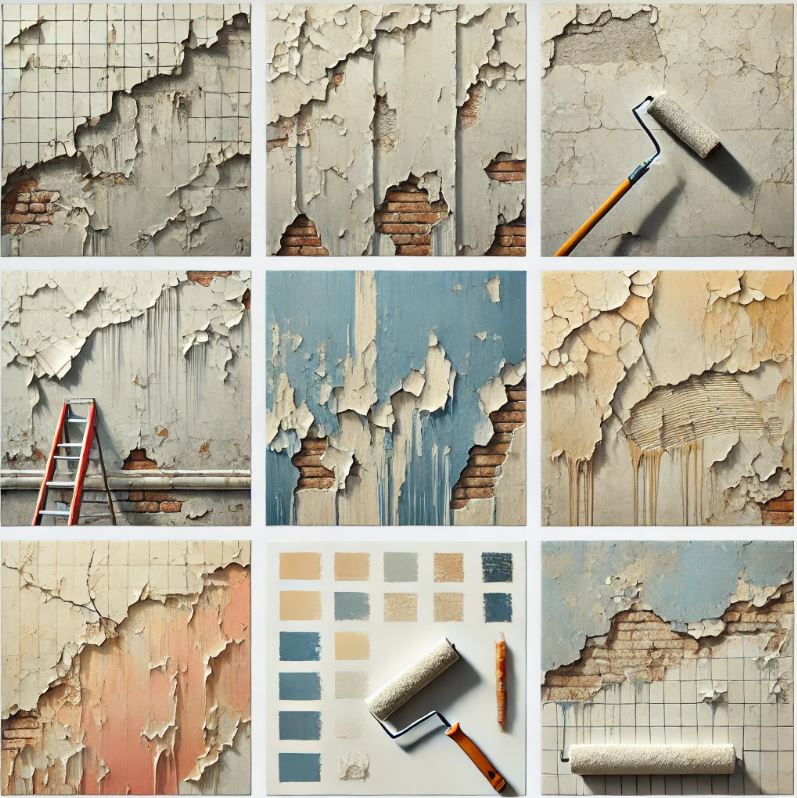Architectural paints are essential materials for decorating and protecting surfaces in both interior and exterior spaces. However, improper application or unsuitable conditions can lead to various failures that affect both the aesthetics and functionality of the surfaces. Below are some of the most common building paint failures and ways to address them.
- Peeling and Flaking
Peeling occurs when paint detaches from the surface, creating cracks and damage. Common causes include improper surface preparation, moisture, or applying paint under poor weather conditions.
Solutions:
- Clean and properly prepare the surface before painting.
- Use a primer suitable for the surface and environment.
- Apply paint in dry and stable weather conditions.
- Chalking
Chalking is the appearance of a white, dusty layer on the paint surface. This occurs when ultraviolet (UV) radiation breaks down the paint’s resins, leading to material degradation.
Solutions:
- Use high-quality paints with UV resistance.
- Prepare the surface by cleaning and sanding before repainting.
- Apply protective coatings or topcoats to enhance durability.
- Blistering and Bubbling
Blisters usually result from moisture or trapped air beneath the paint surface. This can happen when paint is applied on wet surfaces or due to insufficient ventilation.
Solutions:
- Apply paint on fully dry surfaces.
- Use moisture-resistant paints for areas with high humidity.
- Improve ventilation during application.
- Stains and Discoloration
Paint may show stains, often caused by water permeability or stains from substances like smoke, mold, or alkali from the substrate.
Solutions:
- Use appropriate primer to cover stains before applying the final coat.
- Remove mold using cleaning solutions.
- Properly seal surfaces exposed to water.
- Cracking
Cracks in the paint surface are due to the loss of paint flexibility, often caused by over-application of paint or the use of incompatible products between layers.
Solutions:
- Remove cracked areas by sanding or scraping.
- Apply a new coat with thin layers and use products with the same chemical base.
- Discoloration
Discoloration happens when the paint’s color stability is compromised due to UV radiation or exposure to harsh chemicals.
Solutions:
- Choose paints with high UV resistance.
- Use protective varnishes on exterior surfaces.
- Avoid exposing surfaces to aggressive chemical products.
- Fading
Fading occurs when the original brightness and color intensity of the paint diminish, mainly due to sun exposure and weather conditions. UV light is the key factor accelerating this process, especially in dark colors.
Solutions:
- Select paints with high UV resistance, such as those designed for exterior use.
- Apply protective coatings or varnishes to shield the surface from sun damage.
- Repaint with durable paints at regular intervals.
- Lap Marks
Lap marks are visible lines or differences in texture and sheen that occur when paint is applied unevenly or dries inconsistently, especially on large surfaces or when work is interrupted.
Solutions:
- Work using the “wet-on-wet” method, applying paint continuously until the surface is covered.
- Use rollers or brushes that ensure even application.
- Avoid applying paint in high-temperature or high-humidity conditions that speed up drying.
- Sagging
Sagging occurs when paint flows and forms “drops” or thin hanging lines, mainly due to excessive paint application or improper drying conditions.
Solutions:
- Apply paint in thin coats and avoid overloading.
- Use appropriate tools (e.g., brushes or rollers with the right absorption) for application.
- Ensure stable drying conditions without excessive humidity or temperature.
Conclusion
Proper application, the right choice of products, and surface preparation are key elements in avoiding paint failures. By adopting the correct techniques, professionals can ensure the long-term performance and aesthetics of painted surfaces, reducing failures and the need for frequent repainting.

